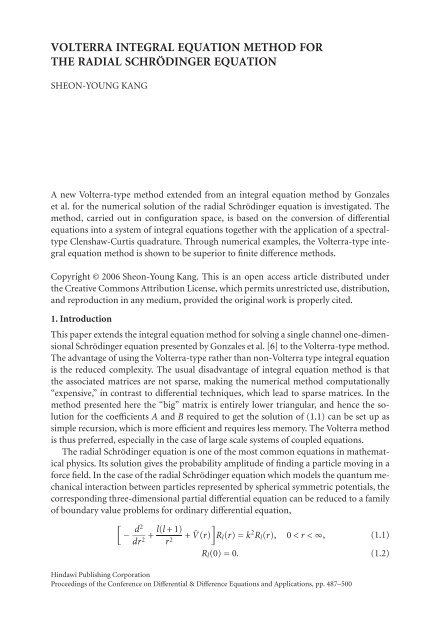DIFFERENtIAl & DIFFERENCE EqUAtIONS ANd APPlICAtIONS
DIFFERENtIAl & DIFFERENCE EqUAtIONS ANd APPlICAtIONS
DIFFERENtIAl & DIFFERENCE EqUAtIONS ANd APPlICAtIONS
You also want an ePaper? Increase the reach of your titles
YUMPU automatically turns print PDFs into web optimized ePapers that Google loves.
VOLTERRA INTEGRAL EQUATION METHOD FOR<br />
THE RADIAL SCHRÖDINGER EQUATION<br />
SHEON-YOUNG KANG<br />
A new Volterra-type method extended from an integral equation method by Gonzales<br />
et al. for the numerical solution of the radial Schrödinger equation is investigated. The<br />
method, carried out in configuration space, is based on the conversion of differential<br />
equations into a system of integral equations together with the application of a spectraltype<br />
Clenshaw-Curtis quadrature. Through numerical examples, the Volterra-type integral<br />
equation method is shown to be superior to finite difference methods.<br />
Copyright © 2006 Sheon-Young Kang. This is an open access article distributed under<br />
the Creative Commons Attribution License, which permits unrestricted use, distribution,<br />
and reproduction in any medium, provided the original work is properly cited.<br />
1. Introduction<br />
This paper extends the integral equation method for solving a single channel one-dimensional<br />
Schrödinger equation presented by Gonzales et al. [6] to the Volterra-type method.<br />
The advantage of using the Volterra-type rather than non-Volterra type integral equation<br />
is the reduced complexity. The usual disadvantage of integral equation method is that<br />
the associated matrices are not sparse, making the numerical method computationally<br />
“expensive,” in contrast to differential techniques, which lead to sparse matrices. In the<br />
method presented here the “big” matrix is entirely lower triangular, and hence the solution<br />
for the coefficients A and B required to get the solution of (1.1) canbesetupas<br />
simple recursion, which is more efficient and requires less memory. The Volterra method<br />
is thus preferred, especially in the case of large scale systems of coupled equations.<br />
The radial Schrödinger equation is one of the most common equations in mathematical<br />
physics. Its solution gives the probability amplitude of finding a particle moving in a<br />
forcefield.InthecaseoftheradialSchrödinger equation which models the quantum mechanical<br />
interaction between particles represented by spherical symmetric potentials, the<br />
corresponding three-dimensional partial differential equation can be reduced to a family<br />
of boundary value problems for ordinary differential equation,<br />
[ ]<br />
− d2 l(l +1)<br />
+<br />
dr2 r 2 + ¯V(r) R l (r) = k 2 R l (r), 0

















